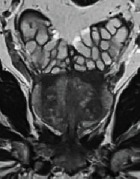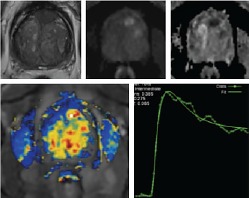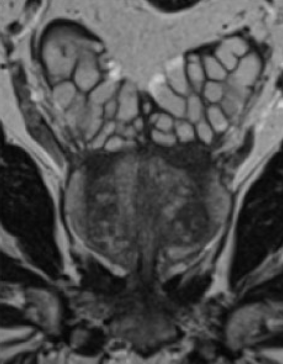Prostate cancer is one of Australia’s worst cancers, impacting many lives every year.
Methods for pinpointing the disease are constantly improving, together with ground-breaking treatments. Nowadays, one of the most accurate tools used by specialists for diagnosis is MRI.
Discover why MRI technology supports thousands of men across Australia with safe and accurate cancer testing.
What is a Prostate MRI?
Magnetic Resonance Imaging (MRI) is a non-invasive medical procedure in which magnetic fields and radio waves scan the body to identify any internal issues. Results are presented as a series of images similar to an X-ray, which are then interpreted by a medical professional and the findings discussed with the patient.
Since the 1980s, this procedure has been used to visualise the prostate and surrounding area in detail. Earlier diagnosis methods – such as PSA blood tests – are still used today, although MRI scanning has been found to show significant prostate cancers. As such, it is a procedure frequently used nowadays by medical experts and urologists in Australia.
How a Prostate MRI Scan Works
A prostate MRI examination evaluates the entire prostate gland and surrounding organs, providing anatomical and structural information and detecting four tumour characteristics. A high strength, 3 Tesla, magnetic field and a multi-channel ‘Torso’ coil are used to capture the high-quality images. The procedure is non-invasive and typically takes around 45 minutes to complete.
Despite it being quick to complete, the prostate MRI scan is a highly technical Multi-Parametric procedure, meaning it takes several factors on board, those being:
- the T2-weighted image of the prostate
- the diffusion of water molecules in a magnetic field
- neoangiogenesis (process of detecting new blood vessels) to show malignant development
Together, the strength and associated magnetic gradients allow the collection of information about tumours as small as 0.5 mL in volume. As such, MP-MRI is calibrated to detect high-grade clinically significant prostate cancer rather than a low-grade disease which can be treated by active management.
MRI scanning machines differ depending on the condition. Patients may be asked to lie down (in an open or closed chamber) or stand/sit when scanning the prostate. Before your scan, the specialist will explain which type of MP-MRI machine they are using for your scan and why.
Prostate MRI Preparation
There are two key considerations when preparing for a prostate MRI: physical and mental.
Physically, there is not much to do to prepare yourself for the procedure. Most doctors or urologists will advise a ‘business as usual’ approach regarding your diet, although you may be asked to keep your food intake to a minimum the night before your scan.
Mental preparation is necessary if you feel anxious about the procedure – which many patients do. The scan itself is non-invasive, quick to complete and has no known side effects, so discomfort is unlikely. It is worth remembering that the scan is among the most effective ways to detect prostate cancer and may uncover that no cancer is present. If cancer cells are detected, early diagnosis is the key to finding a suitable course of treatment as quickly as possible.
MRI-Guided Prostate Biopsy
If a prostate MRI scan detects lesions, the next step is a biopsy. Nowadays, multi-parametric MRI is often used to guide a prostate biopsy as an alternative to TRUS biopsy since it allows the collection of more targeted specimens and increases diagnostic accuracy.
How an MRI-guided Prostate Biopsy Works

Most patients come for a biopsy, having had a prostate MRI scan already. This gives the MRI specialist a clear picture of where the potential cancer is located, allowing for a highly targeted and precise scan ahead of the biopsy. A biopsy needle is inserted into the area, retrieving multiple tissue specimens for analysis.
The MRI-guided Prostate Biopsy Procedure

In the first instance, the procedure is similar to the prostate MRI: the prostate area is fully scanned using MRI machinery. Unlike prostate MRI, which sometimes allows patients to sit, the biopsy component warrants the patient to lie down. The entire procedure, including the scan and biopsy, takes only minutes to complete, although patients are asked to remain in the scanning theatre for twenty minutes afterwards for observation.
Accurate MRI-based localisation and biopsy significantly reduce the required number of passes and sampling errors. Certain regions that can be difficult to reach by ultrasound are now more easily localised using the MRI-guided technique. Thanks to its speed and accuracy, the procedure can potentially replace or reduce the need for TRUS biopsy altogether.
Benefits of Using Prostate MRI Radiology
These current prostate cancer diagnosis methods benefit patients and the medical profession.
MRI technology can effectively streamline the management of patients with a raised PSA level or patients with a diagnosis of low-grade cancer who are currently on an active surveillance program. Traditionally, these patients required multiple ultrasound-guided biopsies of the entire prostate gland – which was time-consuming and uncomfortable for the patient.
MP-MRI may also help to select patients for surveillance, reduce the frequency of re-biopsy and – for patients who do require multiple biopsies – reduce the number of biopsy specimens needed.
Studies have shown that for a lesion greater than 0.5 mLs, MRI-guided biopsy has a sensitivity of 86 – 93% and a specificity of 89 – 94%. This compares to a TRUS ultrasound detection rate of tumours between 6 – 10 mm of only 53%.
The Prostate MRI and MRI-Guided Biopsy procedure allows Australian men a greater chance to detect and deal with prostate cancer.

Katelaris Urology is a leading provider of prostate MRI and prostate biopsy in Sydney.
As a former director of the Prostate Cancer Research Division of the Institute of Magnetic Resonance Research, Dr Katelaris has extensive knowledge of prostate cancer diagnosis and treatment. Now, he focuses on the clinical application of MRI technology and is well known for being one of Australia’s leading experts in MRI diagnostic technology and MRI-guided prostate biopsy.
If you have a question about MRI scanning or the prostate biopsy procedure in Australia, contact our team to book an appointment with Dr Katelaris.
Frequently Asked Question
How long does the prostate MRI scan take?
A Prostate MRI scan is a quick procedure due in part to its non-invasive nature. The scan itself usually takes around half to one hour to complete. Patients have minimal preparation to consider once at the hospital or private urology practice and are free to leave once the procedure is completed.
I received a normal prostate MRI – do I need a biopsy?
If you have been sent for a prostate MRI, you are likely in a high-risk zone (based on age, health or family history) or have a high PSA blood level. An MRI scan looks at the prostate area, assessing the central gland, peripheral zone (accounting for 70% of the prostate) and fibromuscular stroma. Most cancer is found in the peripheral zone, and if your scan has detected none, then it is unlikely you have prostate cancer. Doctors and urologists who still have cause for concern may suggest an MRI-guided biopsy to assess the prostate area for cancer cells further.
Are there any side effects after having a prostate scan?
There are no known side effects resulting from an MRI scan. Sometimes the scan involves placing a coil into the rectum, which may cause a slight temporary discomfort on its insertion. Otherwise, another discomfort is likely caused by the patient’s mental anguish towards the procedure or potential cancer.
Reference
Solan, M. (2021) MRI looking better for detecting prostate cancer, Harvard Health. Available at: https://www.health.harvard.edu/mens-health/mri-looking-better-for-detecting-prostate-cancer
Radiological Society of North America (RSNA) and American College of Radiology (ACR) (no date) Prostate MRI, Radiologyinfo.org. Available at: https://www.radiologyinfo.org/en/info/mr_prostate


